| Corcoran Technical Trading Patterns For January 21 |
| By Clive Corcoran |
Published
01/21/2009
|
Stocks
|
Unrated
|
|
|
|
Corcoran Technical Trading Patterns For January 21
One of the reasons why Technical Analysis is held in high regard by a lot of traders and market players (certainly not by all of them) is that one should not try to attribute day-to-day movements in the markets to some specific factor - even if it is as newsworthy as President Obama's inauguration.
Yesterday the S&P 500, having failed to regain its footing above 850 last week, took the path of least resistance which is to retest the lower boundaries of the trading range that has been in place since the November low.
The suggestion that markets reacted poorly to the new President's oratory is part of the journalistic need to find some kind of narrative to "make sense" of what can often appear as indecipherable market dynamics.
While on the topic of Mr. Obama's speech - the one thing that struck this writer, who watched the events in Washington from the UK, was the man's desire to refrain from the usual politician's posturing. He knows that the things he has to deal with are immense and complex but rather than displaying false bravado and a show of contrived confidence he seemed very down-to-earth about the task ahead. He is a man who seems not to subscribe to all of the Obama hype unlike most of the people who, unfortunately, will be surrounding him.
Reviewing the hourly chart for the QQQQ the downward trendline through the intraday lows is pointing to a retest of the $27 level that was seen on December 5. We may be in a better position in coming days to answer the obvious next question: Will it hold?
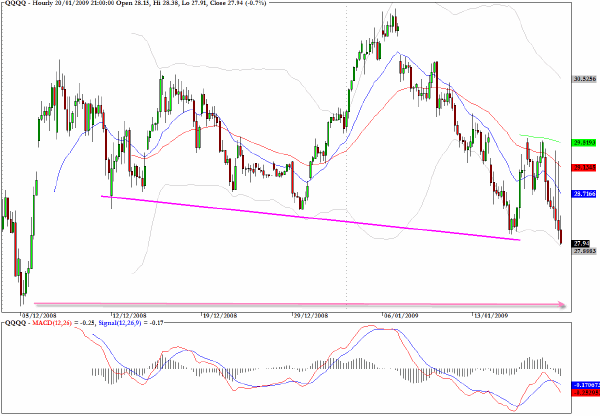
The banking index (^BKX) continues its relentless decline, and sentiment towards the ordinary shares of what still can loosely be called the private banking sector is plumbing new depths. Many are now beginning to seriously discuss the possibility of nationalizing the banking system. Two thoughts arise in this regard.
1. Nationalized banks would bring a whole new meaning to financial transparency and if we end up with a model that more closely resembles a set of public utilities the prospects for earnings growth across the whole economy would have to be re-invented.
We may even out the boom/bust cycles and alleviate some of the inherent instability in the credit-based system we have become accustomed to, but my suspicion is that the global economy would be a lot more pedestrian than it has been over the last 25 years.
2. Why don't we move towards a new bi-modal model for banking?
Routine banking businesses should be run like utility companies. Nothing sexy, no corporate jets and no great surprises when they release their earnings statements.
Creative banking should be separated into different entities for those who prefer high risk/possibly high reward investments, but the taxpayer should never be exposed to their inevitable misjudgments.
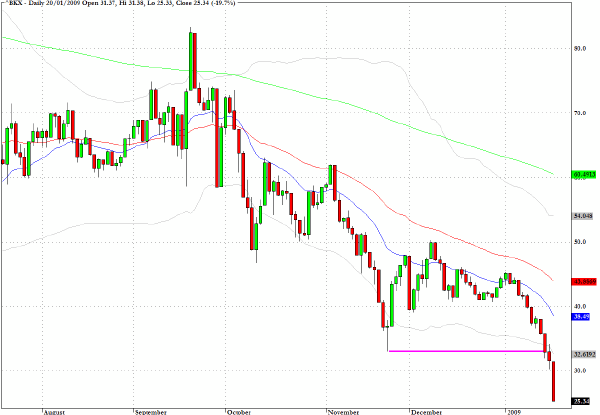
Long-term yields on US Treasuries failed to behave in their expected manner in the wake of yesterday's selloff in equities. Could that provide a glimmer of hope that the current retesting of the November low is not going to result in a further break down for equities or does it suggest that the global appetite for an ever more abundant supply of US government securities is diminishing? It may not be a binary choice that is required to answer that question.
More troublesome was the jump in yield on UK gilts which is causing a lot of discomfort for the Bank Of England and the Treasury. Matters were not helped by an interview with Jim Rogers on Bloomberg in which he urged investors to get out of sterling.
Much as one can find Jim Rogers to be a source of financial wisdom, I just wanted to repeat a posting that I made on a blog site recently.
Being bullish on commodities and China has not been a particularly good trade recently. But being outspoken, wearing a bow tie and being permanently bearish on the US dollar is one way of ensuring that the TV channels will keep calling for interviews.
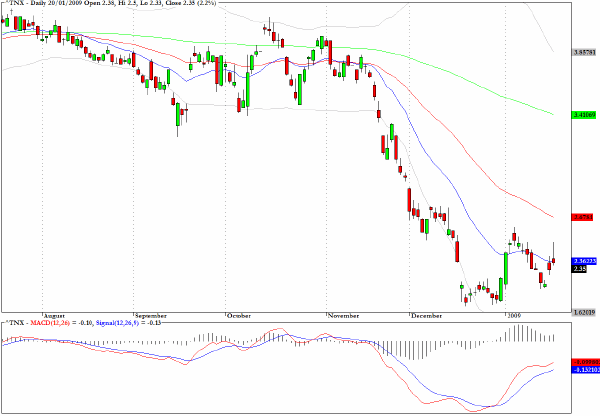
One of the more surprising charts to emerge within yesterday's rather sombre tone was for the exchange traded fund which tracks the price and yield performance of the S&P U.S. Preferred Stock Index, PFF. The chart reveals the extent to which the issue of the potential for bank nationalizations is being taken seriously by institutional holders of bank preferreds.
This would be a good ETF to avoid until the situation becomes clearer.
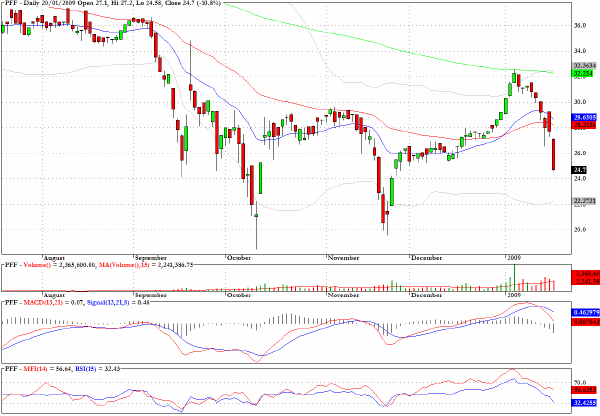
The Shaw Group (SGR) took a big hit yesterday but I would consider the long side in the vicinity of $23.
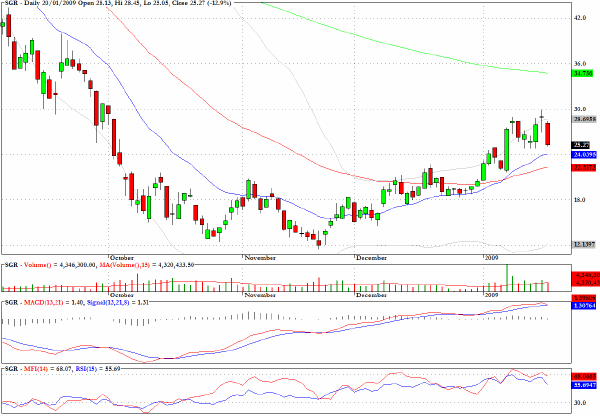
Novellus Systems (NVLS) broke below key moving averages yesterday but the volume was not compelling enough to suggest a short opportunity. Rather this would be worth keeping on a WatchList for an intraday bounce when the overall market selling pressure eases.
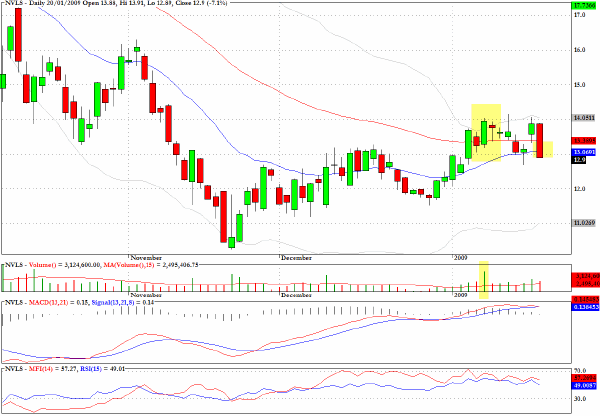
Deere (DE) does look compelling on the short side.
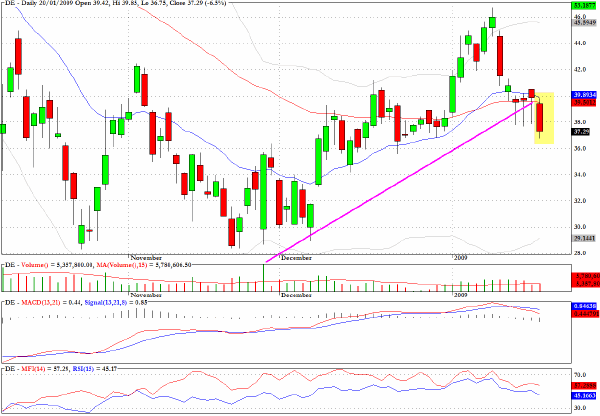
JP Morgan (JPM) has broken decisively below its November low and looks likely to reach a selling climax in coming sessions.
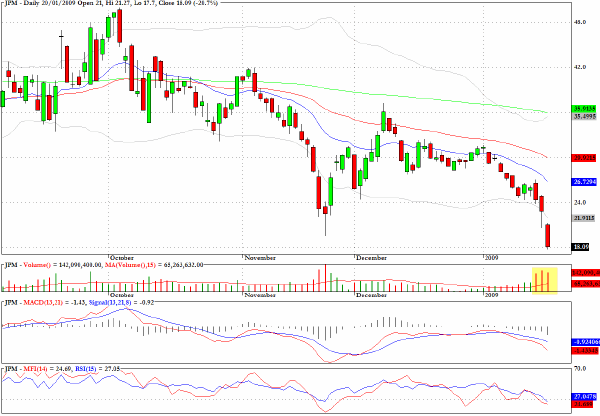
Teekay Shipping (TK) has broken below a key trendline on above average volume.
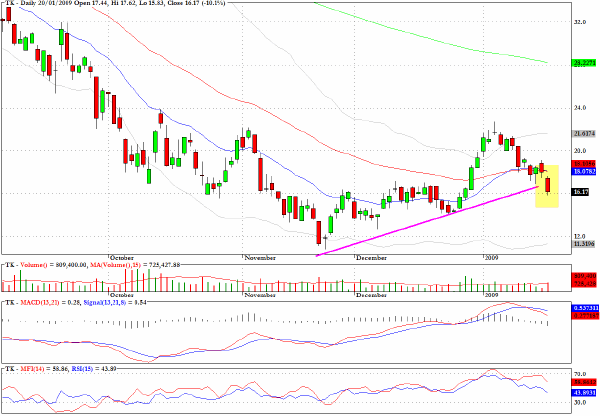
Clive Corcoran is the publisher of TradeWithForm.com, which provides daily analysis and commentary on the US stock market. He specializes in market neutral investing and and is currently working on a book about the benefits of trading with long/short strategies, which is scheduled for publication later this year.
Disclaimer
The purpose of this article is to offer you the chance to review the trading methodology, risk reduction strategies and portfolio construction techniques described at tradewithform.com. There is no guarantee that the trading strategies advocated will be profitable. Moreover, there is a risk that following these strategies will lead to loss of capital. Past results are no guarantee of future results. Trading stocks and CFD's can yield large rewards, but also has large potential risks. Trading with leverage can be especially risky. You should be fully aware of the risks of trading in the capital markets. You are strongly advised not to trade with capital.
|